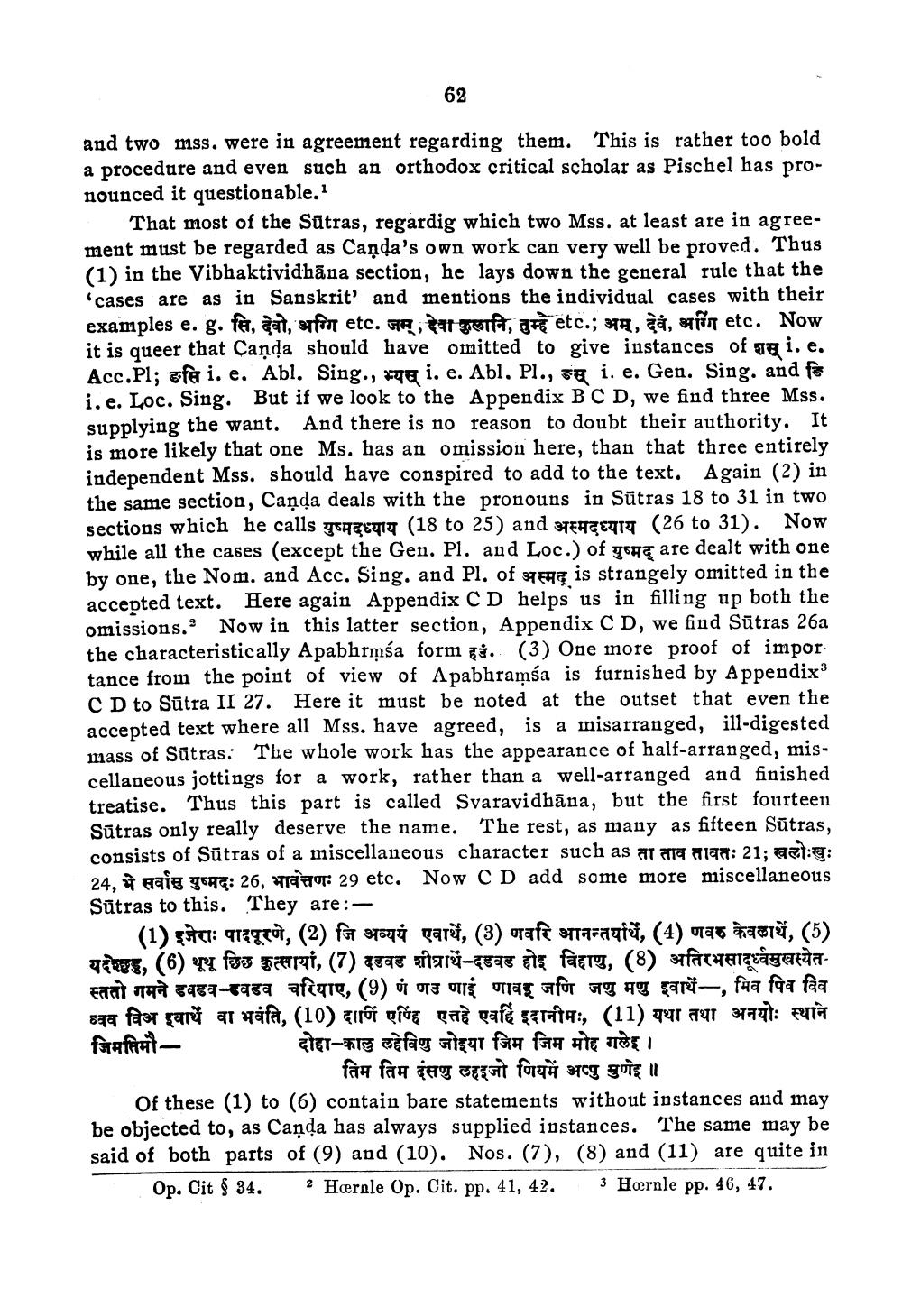________________
62
and two mss. were in agreement regarding them. This is rather too bold a procedure and even such an orthodox critical scholar as Pischel has pronounced it questionable.
That most of the Sūtras, regardig which two Mss. at least are in agreement must be regarded as Canda's own work can very well be proved. Thus (1) in the Vibhaktividhāna section, he lays down the general rule that the 'cases are as in Sanskrit and mentions the individual cases with their examples e. g. fe, aat, affint etc. HR, MA, JR etc.; 37, gå, for etc. Now it is queer that Canda should have omitted to give instances of te i. e. Acc.Pl; se i. e. Abl. Sing., a i. e. Abl. Pl., a i. e. Gen. Sing, and fe i.e. Loc. Sing. But if we look to the Appendix BCD, we find three Mss. supplying the want. And there is no reason to doubt their authority. It is more likely that one Ms, has an omission here, than that three entirely independent Mss. should have conspired to add to the text. Again (2) in the same section, Caņda deals with the pronouns in Sūtras 18 to 31 in two sections which he calls EAEETIT (18 to 25) and STEHTETIT (26 to 31). Now while all the cases (except the Gen. Pl. and Loc.) of you are dealt with one by one, the Nom. and Acc. Sing, and Pl. of 37€ is strangely omitted in the accepted text. Here again Appendix CD helps us in filling up both the omissions. Now in this latter section, Appendix C D, we find Sūtras 26a the characteristically Apabhrmsa form . (3) One more proof of impor. tance from the point of view of Apabhramśa is furnished by Appendix 3 C D to Sūtra II 27. Here it must be noted at the outset that even the accepted text where all Mss. have agreed, is a misarranged, ill-digested mass of Sūtras. The whole work has the appearance of half-arranged, miscellaneous jottings for a work, rather than a well-arranged and finished treatise. Thus this part is called Svaravidbāna, but the first fourteen Sūtras only really deserve the name. The rest, as many as fifteen Sūtras, consists of Sūtras of a miscellaneous character such as at a aiga: 21; azi:: 24, u raig yte: 26, OT: 29 etc. Now CD add some more miscellaneous Sūtras to this. They are:
(1) saci: quaprot, (2) fe 9591 gari, (3) orale smaragii, (4) cat dacief, (5) gius, (6) er for Fami, (7) 4596 -59€ & facta, (8) S tuartågariaस्ततो गमने डवडव-दवडव चरियाए, (9) णं णउ णाई णावइ जणि जणु मणु इवार्थे-, मिव पिव विव ध्वव विअ इवार्थे वा भवंति, (10) दाणिं एण्हि एत्तहे एवहिं इदानीमः, (11) यथा तथा अनयोः स्थाने जिमतिमो-
दोहा-काल लहेविण जोइया जिम जिम मोह गलेइ ।
तिम तिम दंसणु लहइजो णियमें अप्पु मुणेइ ॥ Of these (1) to (6) contain bare statements without instances and may be objected to, as Canda has always supplied instances. The same may be said of both parts of (9) and (10). Nos. (7), (8) and (11) are quite in
Op. cit $ 34. ? Hærale Op. cit. pp. 41, 42. 3 Hærnle pp. 46, 47.




